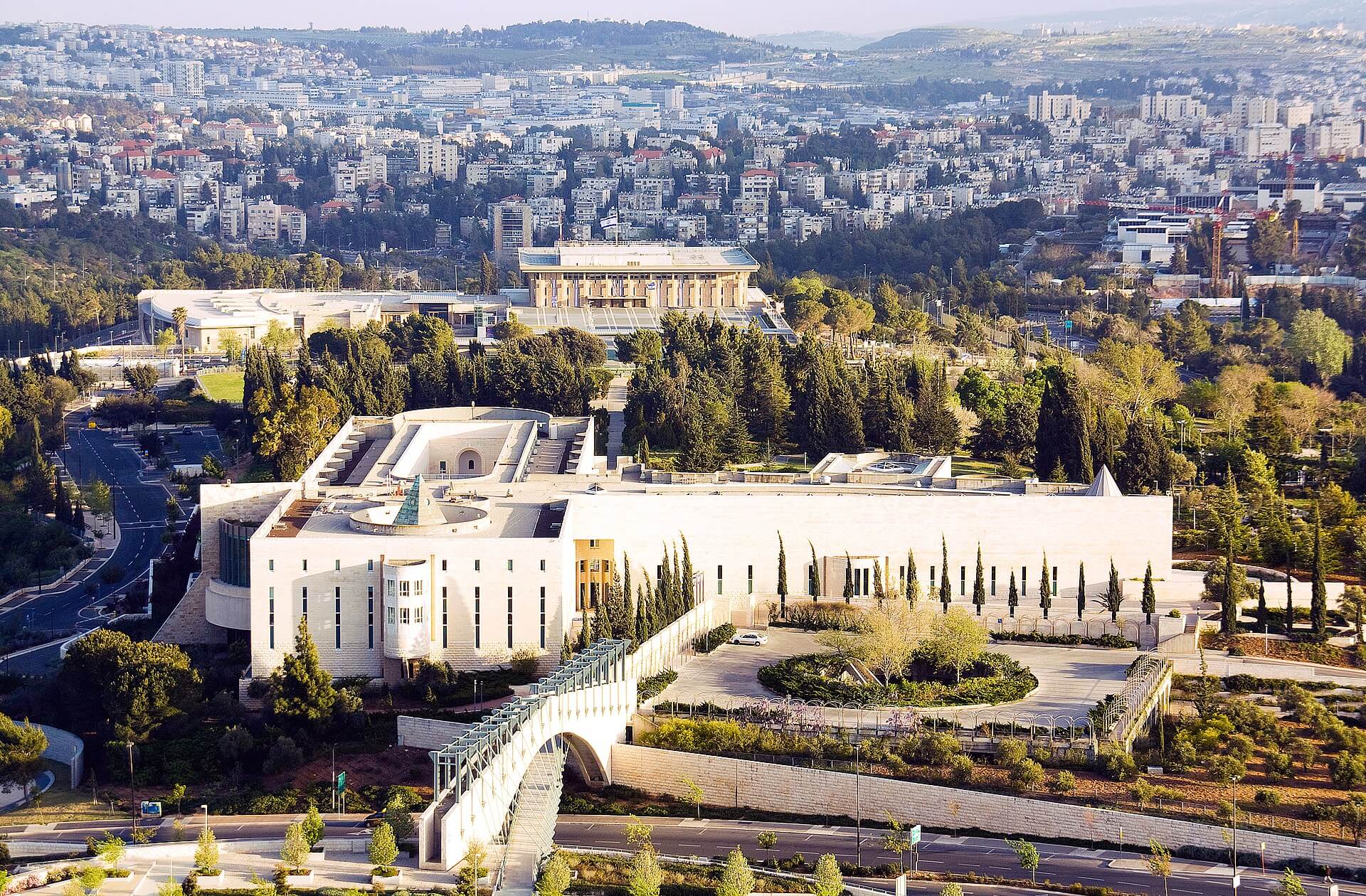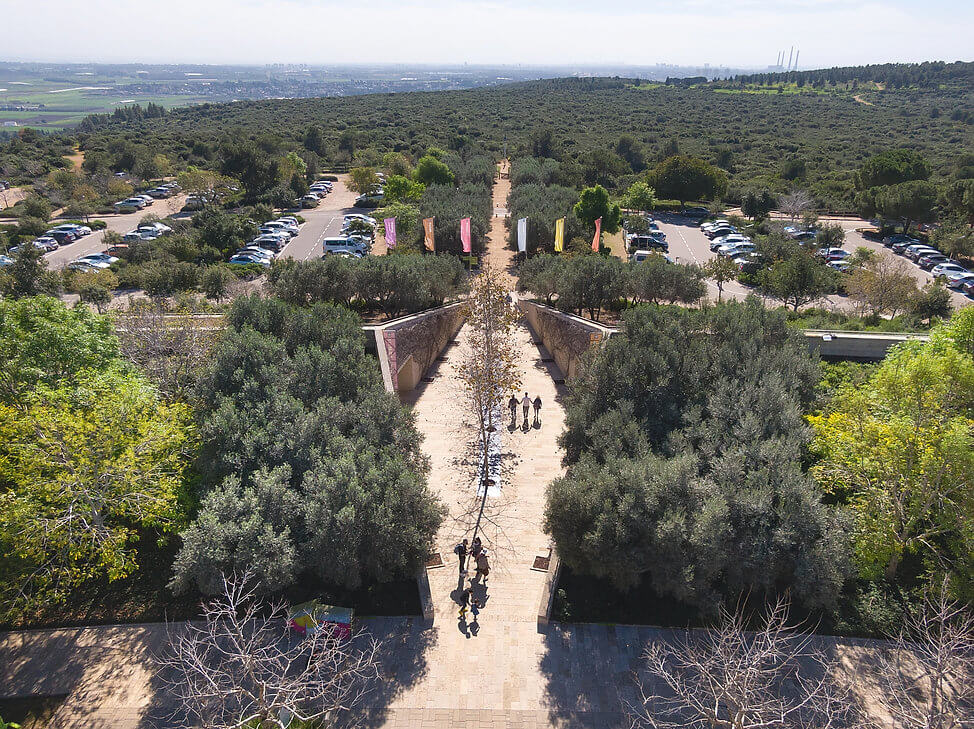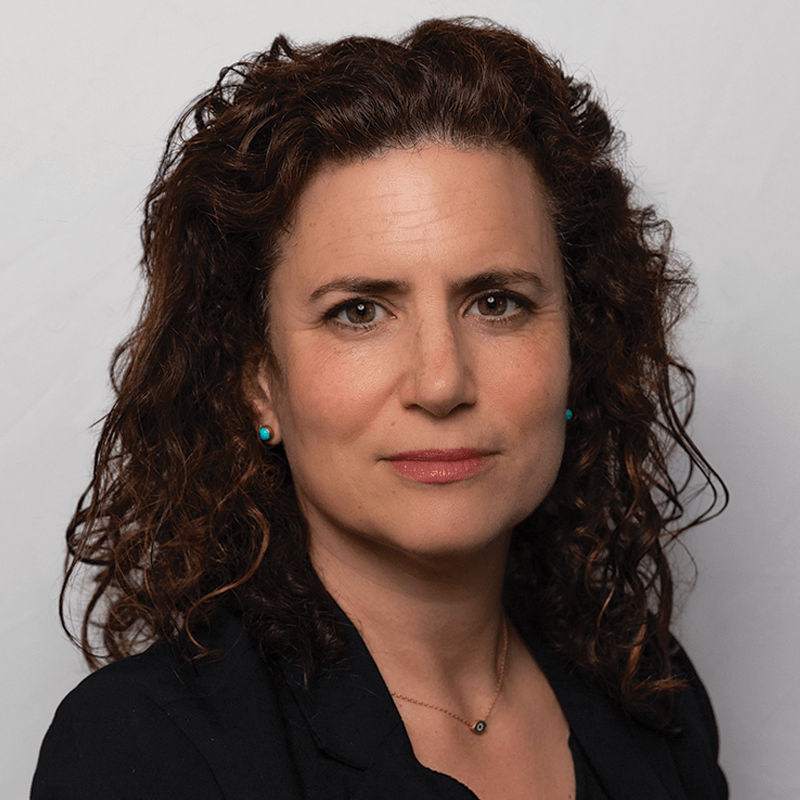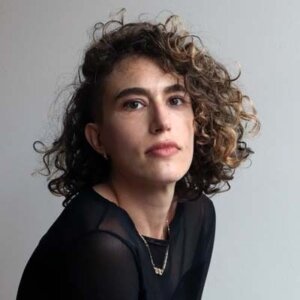Filmmaker Yael Melamede interviewing her mother, acclaimed Israeli architect Ada Karmi-Melamede, in a still from the film ‘Ada: My Mother the Architect.’ Photo-illustration by Salty Features/Nora Berman
In the new documentary Ada: My Mother the Architect, renowned Israeli architect Ada Karmi–Melamede overhears a tour guide delivering a surprising description of the inspiration behind one of her most acclaimed creations: the Israeli Supreme Court building.
“You see here,” the guide says confidently, pointing to a small fountain inlaid in a white, wide courtyard: “This water here is bubbling, to represent the womb.” Karmi-Melamede looks at the camera with raised eyebrows and a grin. “I didn’t know I designed a womb.” The filmmaker, her daughter Yael Melamede, calls out to the tourists listening to the guide with rapt attention: “This is the architect! She designed this building!” The crowd is delighted; the guide’s expression curdles.
Karmi-Melamede and her father and brother, Dov and Ram Karmi, have created scores of residential buildings and public works projects in Israel. Each of them has won the Israel Prize for architecture, widely regarded as the nation’s highest honor for cultural work. Ada’s designs shaped Israel’s Supreme Court, Ben-Gurion Airport and the Ramat HaNadiv nature park, the first building in Israel to be granted “green building” accreditation. No wonder the guide was less than thrilled to be put in an unexpected contest for the spotlight with such a renowned presence.

But while Karmi-Melamede’s story may on the surface seem like a one of Israeli success, it is instead a subtle indictment of what modern life, and, in particular, the state of Israel, has become. Repeatedly upon watching the documentary, I had the sense that if contemporary Israeli politicians (or American ones, for that matter) took some of Karmi-Melamede’s ideas about the proper shape of civic life to heart, that both countries might be in far better shape.
Ada: My Mother the Architect is ostensibly centered around a somewhat familiar narrative about the sacrifices women are forced to make between nurturing their families or their careers. In the mid-1980s, after being denied tenure at Columbia University, Karmi-Melamede left her husband and three children in New York to move back to Israel to design the Supreme Court building with her brother. (At the time, Yael, Ada’s youngest child, was 14 years old.)
Karmi-Melamede would never return to New York, and to this day, her entire family lives in the United States while she remains in Tel Aviv. At the time, Ada thought the move would be temporary while she worked on the Supreme Court building. But her professional opportunities proliferated in Israel, not the U.S., and she followed the work. It’s clear that the personal sacrifice she made is still a source of grief. Yet Ada and her children seem truly at peace with her decision to follow her work to Israel, and proud of her accomplishments. The real story is that of a humble, brilliant architect who lives in a nation that increasingly defies the ideals of both her architecture and the values with which she was raised.
Ada was born in Mandatory Palestine 11 years before the creation of the state of Israel, and she describes the idealistic Zionist environment in which she was raised as one of simplicity and communal sacrifice: “The self was not as important for this generation.”
Instead, Ada says, the focus was on “lehagshim” — a rarely used Hebrew verb that means “to fulfill.” Her job, she was taught, was to nurture the Jewish homeland. To her, that meant engaging with the land on its own terms. So, instead of razing a plot to create a level building, Karmi-Melamede designs with the landscape, curving her buildings to move with the land instead of altering it, and giving them multiple levels that correspond with the earth’s slope. “Buildings with no roots,” she tells Yael, “they all have the same view. There is no connection.”
When we are drawn into a connection with the earth and sky, forced to adjust our bodies to the undulating shape of the earth, we are subtly drawn into making space for those perspectives, and religions, and politics, that are different from our own. Compare that to the modern skyscrapers of glass and steel that Karmi-Melamede describes as “a technological envelope” that encourages a kind of reflective sameness. When a building presents us with the same view, no matter where we are in it, it encourages a philosophical stasis.

An even more pointed message for contemporary Israel comes about midway through the film, when Ada describes how historically, many buildings were built with a center in mind, where people would congregate, mingle and connect with each other. These centers would supply the energy to the rest of the space, rejuvenating the architecture with the mix of people at its core.
“You could say that the merkaz” — “the center” — “of a building is the heart,” she says, adding that “without a common ground, we have no language.”
But today, she mourns, many buildings forgo this heart, and instead, focus on efficiency: transporting the individual as quickly as possible to where they need to go. This, she feels, is a mistake. In her mind, buildings are meant to take us on a journey through the space. Without a route, or a heart, we get stuck in a sclerotic but efficient status quo.
This preference for the organic, over the technologically accomplished, manifests in all parts of Ada’s work. She draws her designs with a pencil, but remarks that her younger colleagues at her eponymous Tel Aviv firm all use the computer for their designs. Something, for her, is missing from their computer-generated blueprints. Perhaps a certain kind of freedom: Ada is constantly using her pencil, even during her interviews with Yael. She’s designing a building, illustrating a design principle, or doodling cats, something she often did on letters for her children after she had left New York.
Automating the design process, she says, smoothes over interesting “corners” — spaces of rough discovery and possible creativity within a building.
And maybe such spaces in a society, too. Israel in 2025 is not the same young nation that Karmi-Melamede helped shape. Instead of centering the desire to put the benefit of the communal over the individual, Israel is led by a man who is prioritizing his own political power to the detriment of the country. Karmi-Melamede’s rooted, graceful buildings map an open-hearted Israel that is rapidly disappearing. Her tech-free approach is increasingly viewed as archaic.
Ada herself is pessimistic about Israel’s future. At one point, Yael asks her if she wishes that her children would move back to Israel. “Not now,” Ada responds pointedly. Yet despite Karmi-Melamede’s fears for the future, I finished Ada: My Mother the Architect feeling incredibly hopeful.
The film articulated principles for a common civic language, an intoxicating possibility of a world where both difference and shared humanity thrive. Even if Israel is failing to embody this possibility, this dream was born from someone formed in this land. Ada Karmi-Melamede represents a kind of unique brilliance and sensitivity that is only possible in Israel. I am certain she is not alone.

I hope you appreciated this article. Before you go, I’d like to ask you to please support the Forward.
Now more than ever, American Jews need independent news they can trust, with reporting driven by truth, not ideology. We serve you, not any ideological agenda.
At a time when other newsrooms are closing or cutting back, the Forward has removed its paywall and invested additional resources to report on the ground from Israel and around the U.S. on the impact of the war, rising antisemitism and polarized discourse.
This is a great time to support independent Jewish journalism you rely on. Make a gift today!
— Rachel Fishman Feddersen, Publisher and CEO

